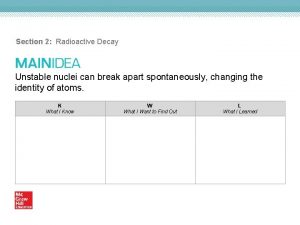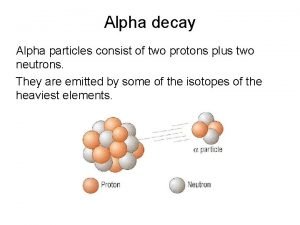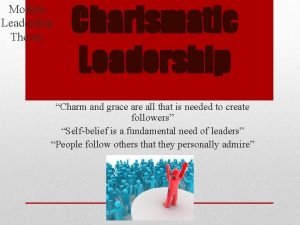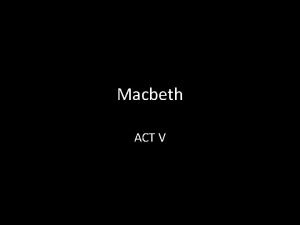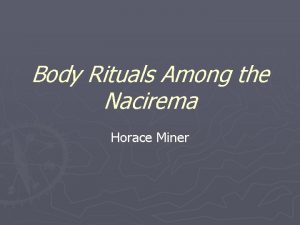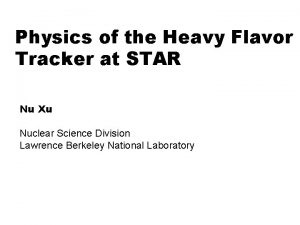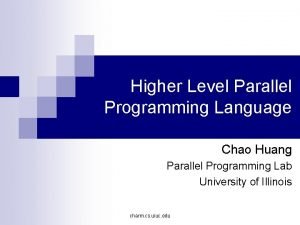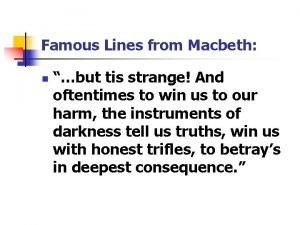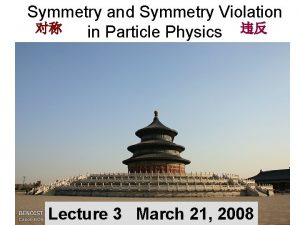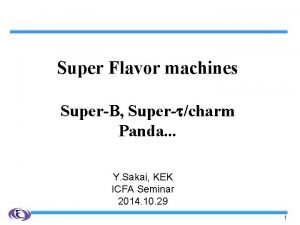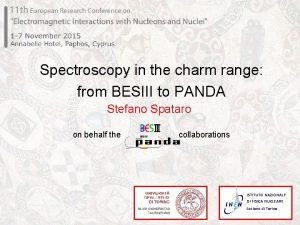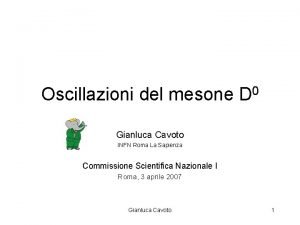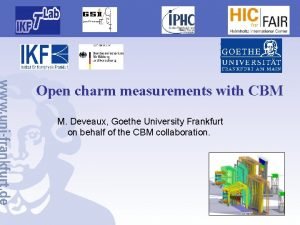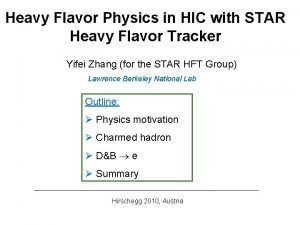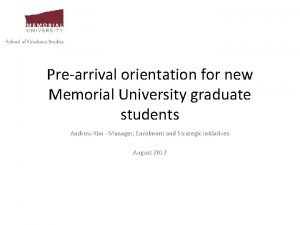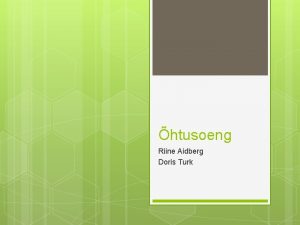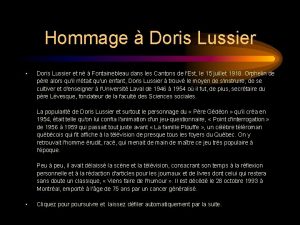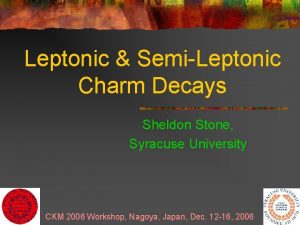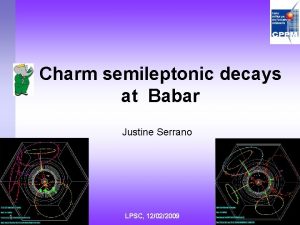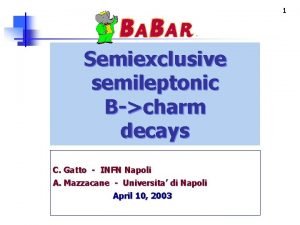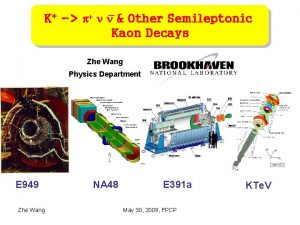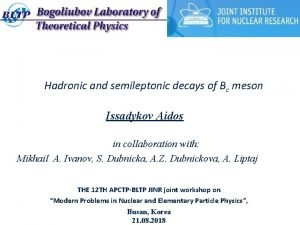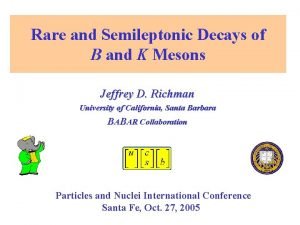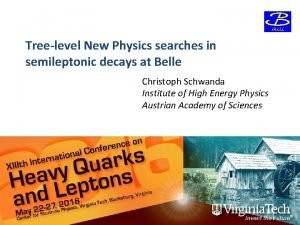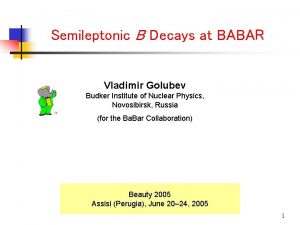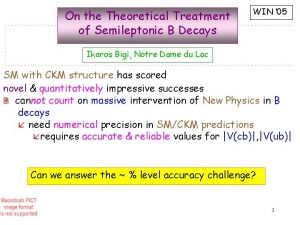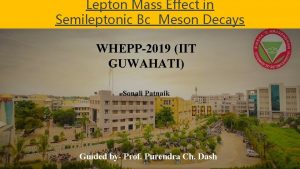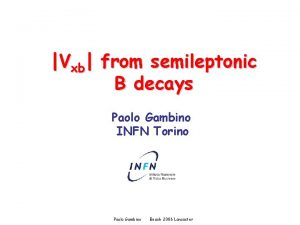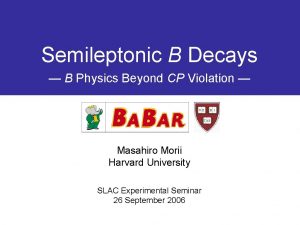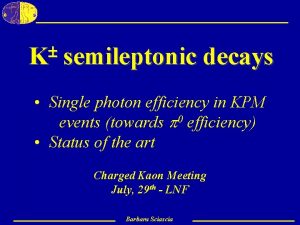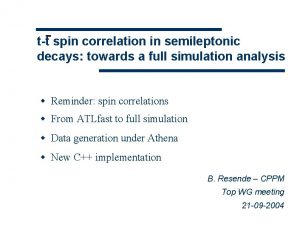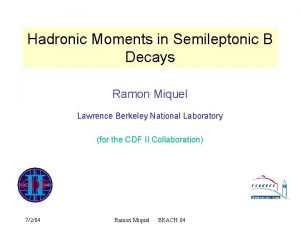Semileptonic Charm Decays Doris Y Kim University of


























- Slides: 26

Semileptonic Charm Decays Doris Y Kim University of Illinois BEACH 2006 July 5, 2006 Content I: Why We Study Charm Semileptonic Decays. II: Recent Analyses on Semileptonic BF, from BES and CLEO-c. III: Form Factors for Pseudo. Scalar l n, from Ba. Bar, Belle, CLEO-c, & FOCUS. IV: Vector l n Form Factors from CLEO -c. 1

I. Charm Semileptonic Decays as Tests of QCD BF (decay rate) study provides a measurement of |Vcq|2 f, etc. The hadronic complications are contained in the form factors, which can be calculated via non-perturbative lattice QCD, HQET, quark models, etc. Charm SL decays provide a high quality lattice calibration, which is crucial in reducing systematic errors in the Unitarity Triangle. The techniques validated by charm decays can be applied to beauty decays. 2 Improvement of CKM @ beauty sector.

Events / 10 Me. V An Example of Semileptonic Decays: CLEO-c (~117 events) K- K+ U ( = Emiss – |Pmiss| ) e+ CLEO-c (56/pb) & BES BF relative to PDG 04 3

II. Inclusive Semileptonic BF. Inclusive BF vs sum of exclusive BF mode D 0 Xe+n CLEO-c 281 pb-1 B (6. 46 ± 0. 17 ± 0. 13)% Si Bi (D 0 Xe+n) (6. 1 ± 0. 2)% D+ Xe+n (16. 13 ± 0. 20 ± 0. 33)% Si Bi (D+ Xe+n) (15. 1 ± 0. 5)% • Consistent with the known exclusive modes saturating the inclusive B. • Some room for new modes? Extrapolated below 0. 2 • Consistent with SL isospin symmetry: 4

V/PS Anomaly in (D K*l n) / ( K l n) Data (2004) DATA Predictions • Early V/PS predictions were 1. 5 – 2 larger than known data ( the A 1 form factor problem ). • Since 1995 predictions have stabilized close to data. • Recent V/PS measurements are consistent: FOCUS (04) CLEO(05) two new BES(06). The V/PS anomaly is rapidly fading away. Plot courtesy of BES 5

III. D Pseudoscalar l n Form Factors Rate P 3 This process can give a clean measurement of CKM angles and powerful tests of LQCD. Unfortunately the rate vanishes at highest q 2 where sensitivity to the form of f+(q 2) is greatest. This is also the zero recoil limit where theory calculations are cleanest. What do we know about f+(q 2) ? 6

Pole Dominance Parameterization: D K l n / l n Dispersion Ds * <Mpole> is 5. 1 s lower than Ds* Integral term is important But there is a less model dependent way of dealing with f + singularities 7

R. J. Hill’s† New Approach to f (q 2) z q 2 Hill makes a complex mapping that pushes the cut singularities far from maximum q 2. cut physical Form factors are given by a simple Taylor series for |z | << 1 Illustrate with B en data [Hill (06)] For B : The cut is very close to the maximum q 2 and f+ (q 2) as q 2 max P f+ (z) f+ (q 2) 10 x q 2 †R. J. 2. 5 x Hill hep-ph/0606023 (FPCP 06) -z After z mapping, the physical and cut region are far apart. The f+ (z) data is well fit with just a straight line as a polynomial. Charm data? ? 8

FOCUS (2004) non-parametric D 0 K m+ n analysis The background only affects the highest q 2 bins. After subtracting known charm backgrounds, f+(q 2) is an excellent match to a pole form with mpole= 1. 91 0. 04 0. 05 Ge. V/c 2 or = 0. 32 (CL 87%, 82%). 9

The New Results from Belle (2006) fit results unquenched LQCD simple pole model One “effective” pole mass (Ge. V) Kln 1. 82 ± 0. 04 stat ± 0. 03 syst ln 1. 97 ± 0. 08 stat ± 0. 04 syst D 0 Kl n modified pole Kln 0. 52 ± 0. 08 stat ± 0. 06 syst ln 0. 10 ± 0. 21 stat ± 0. 10 syst D 0 ln Plot courtesy of L. Widhalm 10

LQCD, FOCUS & Ba. Bar: q 2 and z-trans ~100 K Hill transformation gives a nearly linear f(Z) for D K data. The expansion should converge very rapidly since |z| << 1 in this decay From Hill (06) Ba. Bar FOCUS 13 K -z Plus some new results from CLEO-c 11

Preliminary Untagged D K/ e n from CLEO-c CKM info Modified pole Neutrinos are determined by energy-momentum balance AND the recoil D tagging method is not used. Slightly lower than previous measurements charm vector semileptonic decays 12

IV. D Vector l n Decay Korner+Schuler (1990) Present in K* l nu H 0(q 2), H+(q 2), H-(q 2) are helicity-basis form factors computable by LQCD A new factor h 0 (q 2) is needed to describe s-wave interference piece. 13

KS / GS model for H and H 0 K&S write H and H 0 as linear combinations of two axial and one vector form factors. Two approaches are used to parameterize them: Spectroscopic pole dominance Versus B&K style “effective” poles The traditional method. • V(q 2) essentially same as B&K with one physical and one effective 1 - poles. But spectroscopic pole dominance should work poorly at high q 2 Need for alternative… • A 1(q 2) forced to be one effective 1+ pole • A 2(q 2) has two effective 1+ poles 14

Spectroscopic Pole Dominance D V l n Fits D+ K* l+ n RV RV R 2 time R 2 The latest results FOCUS (2004) on Ds m n form factors are consistent with those for D+. Experimental results are very consistent with small errors. But must we trust/rely on spectroscopic pole dominance? 15

cos. L A non-parametric Approach 7 8 9 4 5 6 1 2 3 D: M+ M- M 0 Disentangle helicity form factors based on their different angular bin populations. cos. V 16

Non-parametric D+ K +e+n Form Factors (281 pb 1) CL = 24% FOCUS model CL = 40% Low q 2 peaking of H 0 and h 0 is very apparent. CL = 59% CL = 0. 2% Apart from interference term the CL are rather good. 17

Pole Mass Sensitivity in Data MV=2. 1 MA=2. 5 Constant Ai & V Data fits spectroscopic poles and constant form factors equally well. 18

Preliminary Z transform of PS-V decay by Hill Analysis of CLEO non-parametric data by R. J. Hill (private communication) The Hill- transformed CLEO non-parametric H 0 data seems nearly constant. P H 0(z) CLEO data D+ K + e+ n -z For D K* decays, the z range is 4 small than for D K. Hence, one expects that the H 0 data is nearly constant after transformation, which is confirmed in data 19

Confirming the s-wave in D+ K + e+ n FOCUS CLEO-c The disappearance of the interference above the pole implies the above phase relationships between the BW and the s-wave amplitude. 20

Summary (1) Inclusive BF of semileptonic decays from CLEO-c. • From 281/pb at (3770), much better than the PDG 04. SL(D 0)/ SL(D+) = 1. Known decay modes almost saturating. (2) Active Form factor analyses for D Pseudoscalar l n by several experiments are compared to the latest unquenched light-flavor LQCD results, B&K model & Hill transformation. (3) Form Factor measurements for D V l n from CLEO-c 281/pb and FOCUS. • H+, H 0 appear consistent with the spectroscopic pole dominance model and consistent with Hill. (4) Not covered here & Coming soon: Exclusive BF decays, rare decays, Ds semileptonic decays, more form factors, etc. (5) Looking forward to new data from B factories, CLEO-c, BES III, and next-generation charm experiments. 21

Question slides 22

Search for D-wave K Add a D-wave projector Guard against “phase cancellation” by showing above and below the K* q 2 Ge. V 2 23

FOCUS D 0 K m+ n analysis 12, 840 K m+ n Dm cut RS-WS MC WS • A good muon candidate. • Cerenkov ID for K/ candidates. • L/s > 5 between two good vertices. • D* tag required, and wrong sign soft subtraction. Km frame • Jump to Km rest frame • The D and D* mass constraints the neutrino lies on a cone around the soft pion. q 2 reconst Fixed Target Neutrino closure • Pick the that points the D closest to the primary vertex. Lab frame q 2 actual 24

Expected q 2 Dependence of Helicity FF Only 0 helicity components can survive at q 2 0 because of V-A helicity laws. 25

Comparing CLEO-c & FOCUS Results Preliminary CLEO D+ K en q 2 Data 2472 res FOCUS D+ K mn Data 11397 q 2 res 26
 Nuclear decays and reactions section 2
Nuclear decays and reactions section 2 Alpha decay of uranium-238
Alpha decay of uranium-238 Charm and grace
Charm and grace Despair thy charm and let the angel meaning
Despair thy charm and let the angel meaning Winston churchill charisma
Winston churchill charisma Language
Language O the wonderful cross
O the wonderful cross Nacirema horace miner
Nacirema horace miner What incantation shrinks an object
What incantation shrinks an object Charm mesom
Charm mesom Charm programming language
Charm programming language But 'tis strange and oftentimes
But 'tis strange and oftentimes Weather tomorrow nnn
Weather tomorrow nnn Ffa charm
Ffa charm A charm quark has a charge of approximately
A charm quark has a charge of approximately Virtual production
Virtual production Charm
Charm Gianluca cavoto
Gianluca cavoto Charm
Charm Heavy flavor physics
Heavy flavor physics Supertunia mulberry charm
Supertunia mulberry charm Arrival form mun
Arrival form mun Ninfa de doris hija la más bella
Ninfa de doris hija la más bella Dekrüpteerimine mobiil id
Dekrüpteerimine mobiil id Doris turk
Doris turk Texte de doris lussier sur la mort
Texte de doris lussier sur la mort Doris fleischman
Doris fleischman
